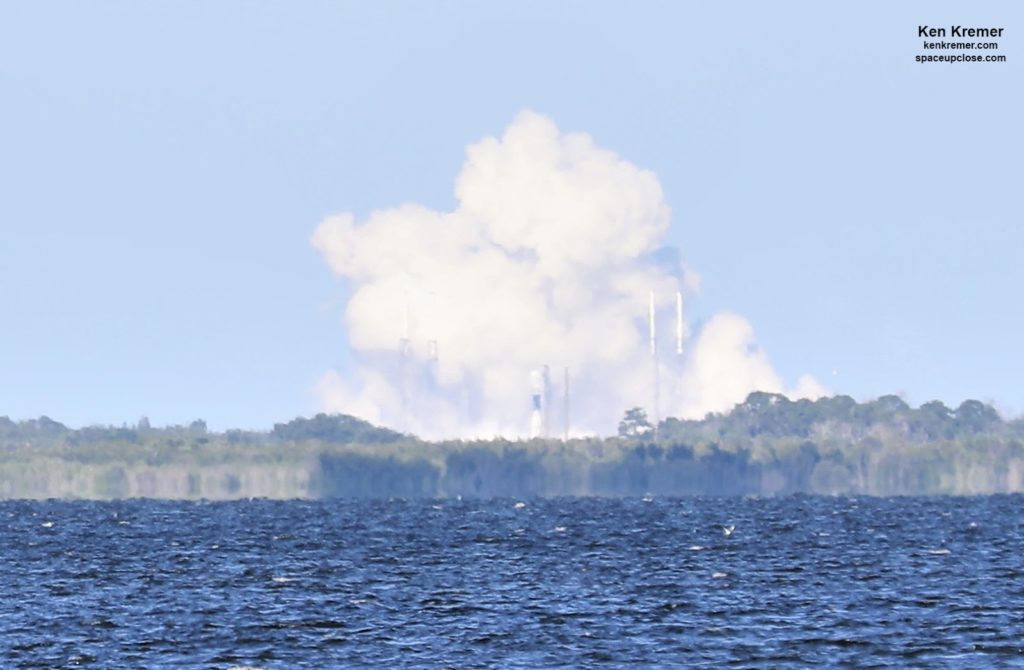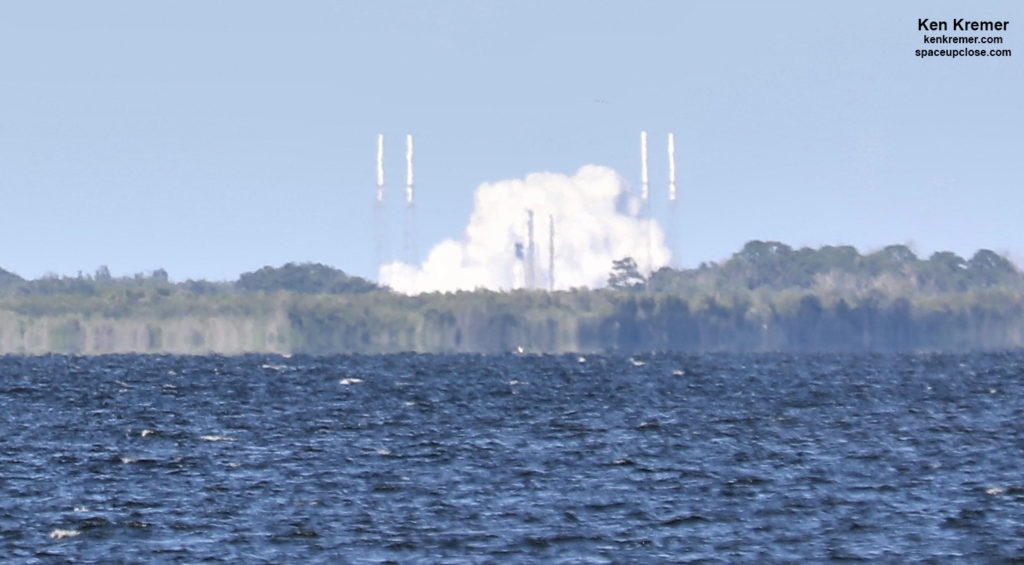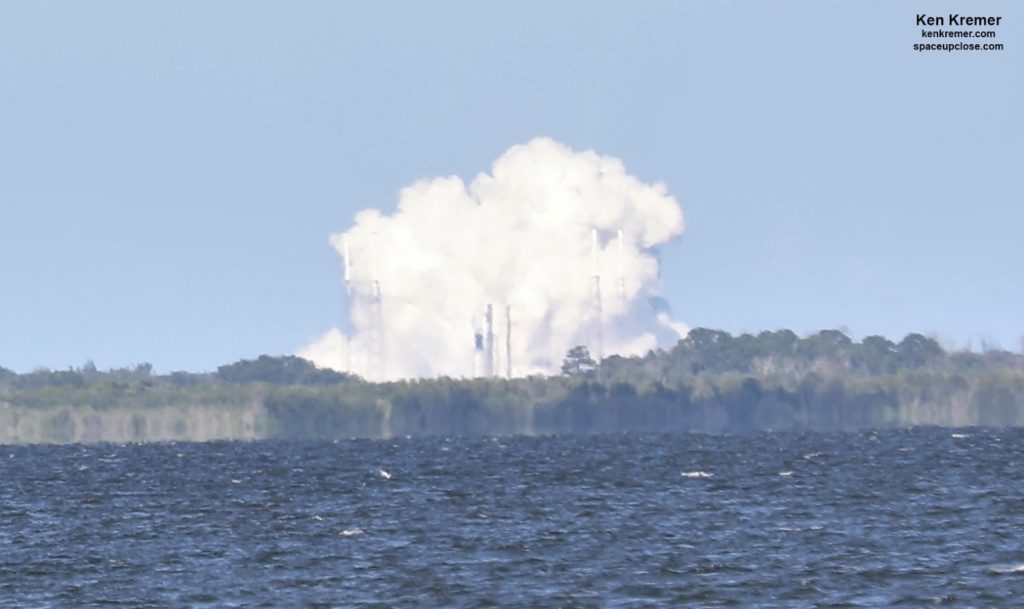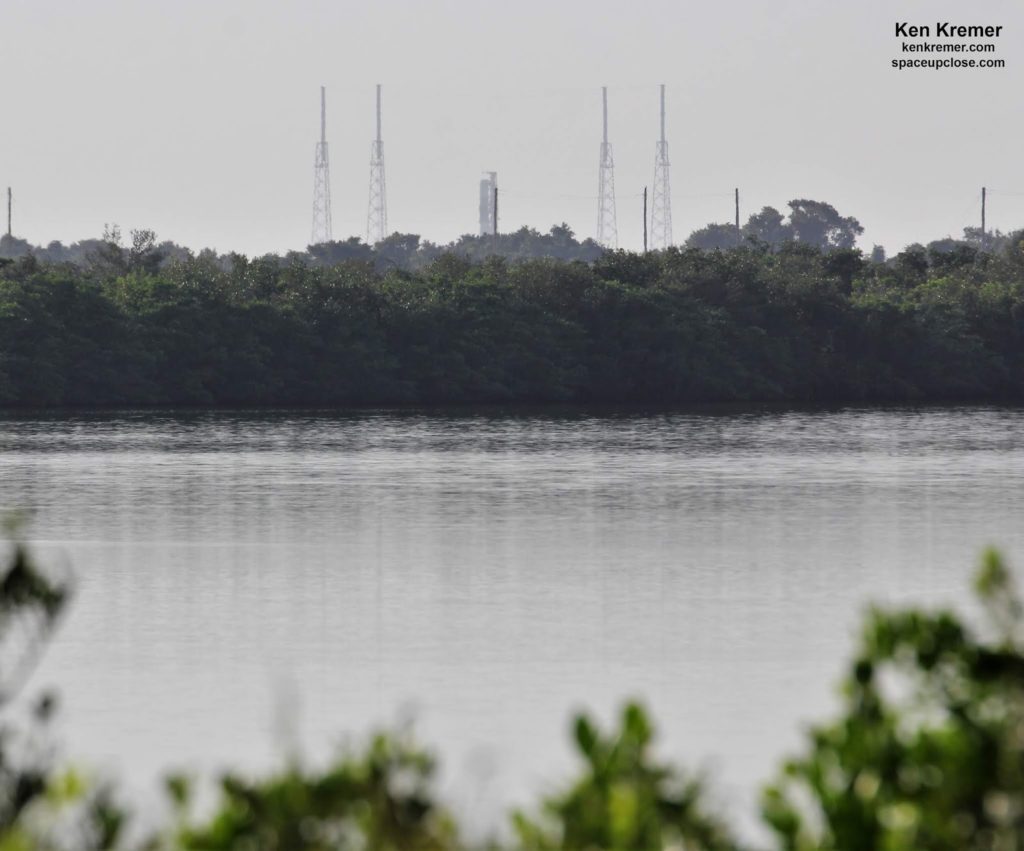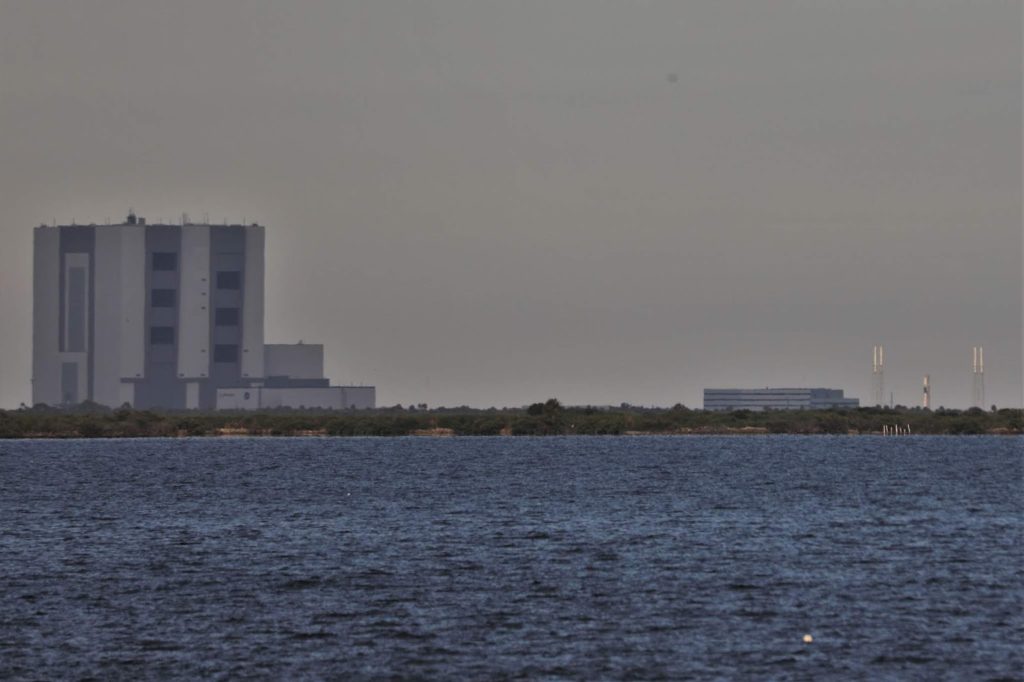Ken Kremer — SpaceUpClose.com & RocketSTEM – 20 July 2019
TITUSVILLE/KENNEDY SPACE CENTER, FL – After several days of delays – and amidst ongoing celebrations marking the 50th anniversary Mankind’s 1st landing on the Moon on Apollo 11 – SpaceX engineers at last conducted a successful static fire test on Friday, July 19 of the first stage engines the firms private Falcon 9 rocket that will soon launch on a cargo delivery mission
for NASA with some three tons of science and supplies to the International Space Station (ISS) from the Florida Space Coast.
Among the cargo will be a very important docking adapter known as International Docking Adapter-3 (IDA-3), which is required to be on station in order for the new commercial crew spaceships from SpaceX and Boeing to dock at the orbiting outpost.
The brief hold down static hot fire test involving ignition of all nine Merlin 1D Falcon 9 first stage engines was carried out by SpaceX engineers at 6 p.m. EDT (2200 GMT) on pad 40 at Cape Canaveral Air Force Station, Fl., using a recycled once used booster of the upgraded Block 5 version of their workhorse Falcon 9.
Check out my exclusive Space UpClose eyewitness photos captured about 13 miles away this late Friday afternoon along the Indian River lagoon in Titusville, FL.
The ‘Sure to be Spectacular’ liftoff will now take place 3 days later than previously planned – with SpaceX and NASA now targeting 6:24 p.m. EDT (2224 GMT) Wednesday, July 24, for the Falcon 9 rocket launch of the unpiloted and recycled Dragon CRS-18 cargo ship from Space Launch Complex 40 at Cape Canaveral Air Force Station in Florida.
Unfortunately the weather outlook is unfavorable – so plan for a scrub.
The window is ‘instantaneous’ meaning any delay for weather or technical reason forces a minimum 1 day scrub.
eighteenth resupply mission to the @space_station,” SpaceX tweeted.
rocket.
out to the point of a brief engine ignition lasting around 3 seconds or so.
With the pad in daylight with prefect weather and visibility and little haze I was able to observe a large vapor cloud of exhaust emitted from the Falcon 9 first stage in the moments after ignition. I did not hear the rockets engines ruble several seconds later as the vapor cloud dissipated.
The hold down engine test with the erected Falcon 9 rocket involved the ignition of all nine
Merlin 1D first stage engines generating some 1.7 million pounds of thrust at pad 40 while the two stage rocket was restrained on the pad – minus the Dragon payload.
pad 40 hanger to attach the Dragon cargo spacecraft.
May.
This Dragon CRS-18 Dragon cargo ship previously launched in April 2015 and December 2017.
“The Dragon spacecraft supporting this mission previously visited the @space_station in April 2015 and December 2017,” SpaceX tweeted.
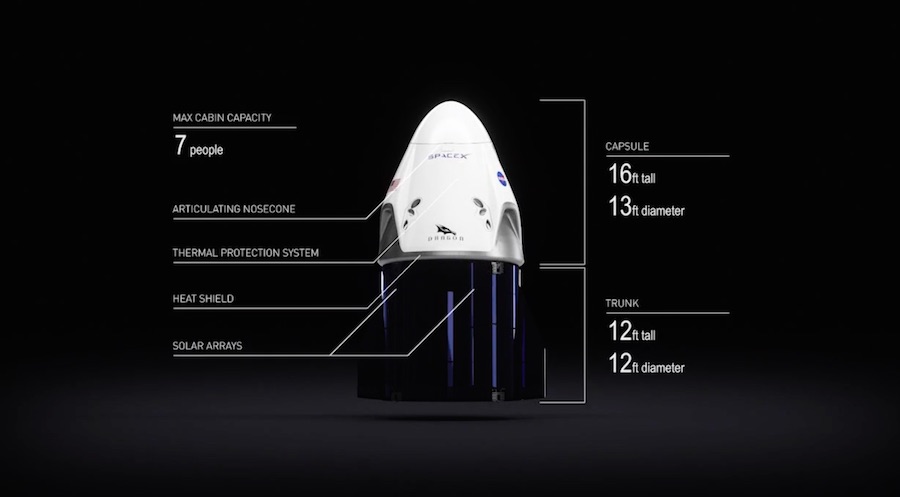 |
|
SpaceX Dragon spacecraft diagram. Credit: SpaceX
|
The prior CRS-17 resupply flight successfully flew in May 2019 from pad 40 on the CRS-17 resupply mission.
The two stage Falcon 9/Dragon rocket stands about 213-feet (65-meters) tall.
The weather outlook is not good. Meteorologists with the U.S. Air Force 45th Space Wing predict only a 30% chance of favorable weather for the SpaceX Dragon launch on July 24.
The primary weather concerns are cumulus clouds and their associated anvil clouds, as well as lightning.
The 20-foot high, 12-foot-diameter Dragon CRS-16 vessel is jam packed with more than 5500 pounds (2500 kilograms) of science experiments, research hardware, space parts, food water, clothing and more supplies for the six person Expedition 60 crew.
The research gear will support dozens of the more than 250 science and research investigations that will occur during Expeditions 60 and beyond.
Watch this brief video about CRS-18 science:
Video Caption: Dozens of scientific experiments are scheduled to travel to the International Space Station aboard a Dragon cargo spacecraft in late July. This 18th SpaceX Commercial Resupply
Services (CRS) contract mission for NASA blasts off from Cape Canaveral Air Force Station in Florida on a Falcon 9 rocket. Credit: NASA
Furthermore Dragon’s unpressurized trunk is carrying the Boeing-built International
Docking Adapter-3 (IDA-3) to orbit.
Astronauts will use the stations Canadian-built robotic arm to pluck IDA-3 from the trunk and install it onto the space-facing zenith port of the station’s Harmony module.
IDA-3 will become the second docking adapter for the astronaut carrying commercial crew vehicles –joining IDA-2 – thereby allowing both the Boeing Starliner and SpaceX Crew Dragon to simultaneously dock at the ISS and offering vast advantages and expanding opportunities to NASA to overlap commercial crew missions – much like is currently possible for Russian Soyuz capsules.
IDA-3 replaces IDA-1 which was lost when a prior SpaceX Dragon was lost during a Falcon-9 launch failure in 2015 of the CRS-7 mission.
IDA-2 arrived in 2016 and was used successfully for the first time for the docking of the
SpaceX Demo-1 test flight in March 2019.
“Dragon will dock to the space station Friday, July 26, and be greeted by NASA astronauts Nick Hague, Christina Koch and Andrew Morgan.
Using the station’s robotic arm, Hague will grab, or grapple, Dragon with Koch providing backup. Morgan will assist by monitoring telemetry during Dragon’s approach. After Dragon capture, mission control in Houston will send ground commands for the station’s robotic arm to rotate and install it on the bottom of the station’s Harmony module,” according to NASA.
SpaceX was awarded an approximately $3.1 Billion contract from NASA to launch 20 Dragon cargo missions to the orbiting outpost through 2019 under the Commercial Resupply Services-1 (CRS-1) agreement that was amended in 2015 and increased from an original value of $1.6 Billion.
Three missions remain: CRS-18, CRS-19 and CRS-20.
NASA also awarded a CRS contract to Northrop Grumman that has likewise been increased.
Both companies also won new cargo mission contracts under the Commercial Resupply Services-2 (CRS-2) agreement awarded last year.
Ken will be onsite at the Kennedy Space Center and Cape Canaveral Air Force Station for live reporting of the SpaceX CRS-18 mission launch.
Watch for Ken’s continuing onsite coverage of NASA, SpaceX, ULA, Boeing, Lockheed Martin,
Northrop Grumman and more space and mission reports direct from the Kennedy Space Center, Cape Canaveral Air Force Station, Florida and Wallops Flight Facility, Virginia.
Stay tuned here for Ken’s continuing Earth and Planetary science and human spaceflight news: www.kenkremer.com –www.spaceupclose.com – twitter
@ken_kremer – email: ken at kenkremer.com
Dr. Kremer is a research scientist and journalist based in the KSC area, active in outreach and interviewed regularly on TV and radio about space topics.
Ken’s photos are for sale and he is available for lectures and outreach events
Ken’s upcoming outreach events:
Jul 22/23: Quality Inn Kennedy Space Center, Titusville, FL, evenings. Learn more
about the upcoming/recent NASA Orion Ascent-2 Abort test Falcon Heavy, NASA 2024 Moon landing goal, SpaceX Starlink-1, SpaceX Falcon 9/CRS-17 launch to ISS, SpaceX Demo-1 launch/test failure, SpaceX Beresheet launch, NASA missions, ULA Atlas & Delta launches, Northrop Grumman Antares, SpySats and more
Ken will display his photos for sale



